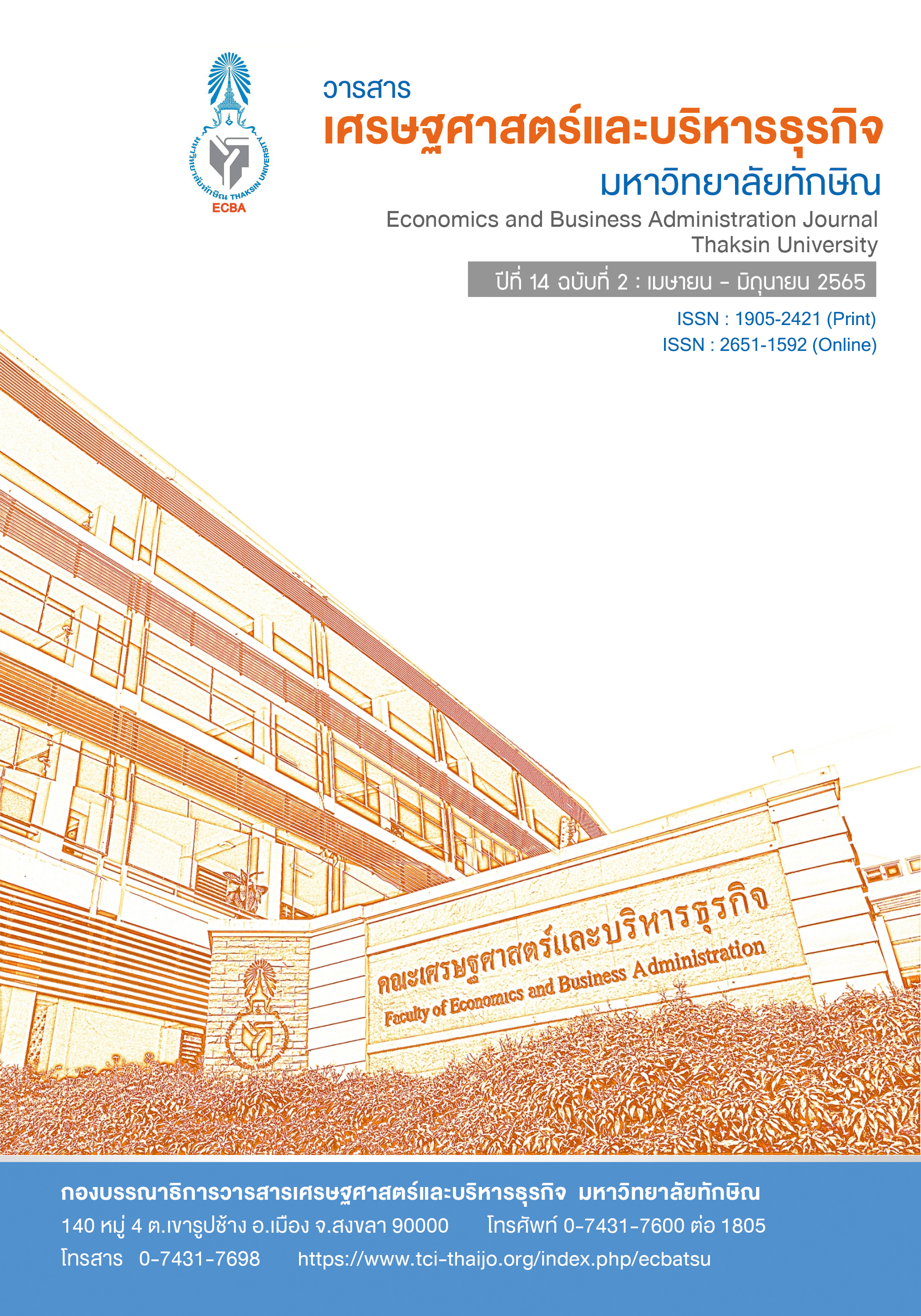Effect of Climate Change on Milk Production Dairy Cows Farming in Thailand
Keywords:
Weather, Climate, Climate Change, Milk ProductionAbstract
This study aims to analyze the effects of climate change on milk production in dairy cow farms in Thailand, which is a nutrient-rich and vital protein source that promotes the population’s health nationwide. The study is conducted by applying an econometric model to analyze the panel data of Thai dairy farms in 3 areas where there is the most significant number of dairy cattle in 11 provinces in the last 20 years (B.E 2543-2562). The data is analyzed by Fixed Effect and estimated by Feasible Generalized Least Squares: FGLS) to approximate the average coefficient equation. The study found that the increase in average temperature and humidity for 1 percent indicated a decrease in milk production within 1.45 and 1.10, respectively. The increase in the number of dairy cows and time for 1 percent indicated an increase in milk production within 0.83 and 0.46 percent, respectively. The findings show that the climate, such as temperature and humidity, are essential variables to produce milk. Therefore, agricultural sectors ought to prepare and adjust to minimize the impacts in the future by adjusting the dairy farm area and the way of raising the cows. The related sectors can also inform the regulations of standard farming management and support various means to reduce the risks continuously.
References
Alexandratos, N., & Bruinsma, J. (2012). World agriculture towards 2030/2050: the 2012 revision. ESA Working paper No. 12–03. FAO, Rome.
Battese, G. E., Rambaldi, A. N., & Wan, G. H. (1997). A Stochastic Frontier Production Function with Flexible Risk Properties. Journal of Productivity Analysis, 8(1), 269–280.
Boonkum, W., Misztal, I., Duangjinda, M., Pattarajinda, V., Tumwasorn, S., & Sanpote, J. (2011). Genetic effects of heat stress on milk yield of Thai Holstein crossbreds. Journal of Dairy Science, 94(1), 487-492.
Chase, E. (2014). Climate Change Impacts on Dairy Cattle. Climate Change and Agriculture: Promoting Practical and Profitable Responses. Department of Animal Science, Cornell University.
Department of Livestock Development. (2015). Information And Communication Technology Center. [Online]. Retrieved November 3, 2020 from: https://ict.dld.go.th/webnew/index.php/th/service-ict/report. (in Thai)
Hahn, G.L. (1981). Housing and management to reduce climatic impacts on livestock. Journal of Animal Science, 52(1), 175-186.
Hurst, P., Termine, P., & Karl, M. (2005). Agricultural workers and their contribution to sustainable agriculture and rural development. FAO, Rome.
Intergovernmental Panel on Climate Change. (2007). Climate Change 2007: The Physical Science Basic.Contribution of Working Group I to the Fourth Assessment Report of the Intergovernmental Panel on Climate Change. Cambridge: Cambridge University Press.
Just, R. E., & Pope, R. D. (1979). Production Function Estimation and Related Risk Considerations. American Journal of Agricultural Economics, 61(1), 276–284.
Kittilertpaisan , J (2003). Microeconomics. Sakon Nakhon Rajabhat Institute. faculty of Management Science. (in Thai)
Lamesegn, D. (2019). Review on effects of climate change on livestock production in Ethiopia. Online Journal of Animal and Feed Research, 8(6), 185-189.
Office of Agricultural Economics.(2020).Agricultural Information Center reports the quantity of raw milk production , Report file. (in Thai)
Pierre, N. Cobanov, R.B., & Schnitkey, G. (2003). Economic Losses from Heat Stress by US Livestock Industries. Journal of Dairy Science, 86(Suppl.), 52–77.
Sinnarong, N. (2013). The Potential Impacts of Weather on Rice Production and Evaluation of Agroadaptation Measure for Northern Thailand. The Journal of Interdisciplinary Networks, 2(2), 450-456.
Sinnarong, N. (2018b). The association of weather variables with rice production and simulation of agro adaptation measure for northeast Thailand: evidence from panel data model. International Journal of Global Warming, 14(3), 330-355.
Tarabany, E. (2017). Production and health performance of Holstein, Brown Swiss and their crosses under subtropical environmental conditions. Animal Production Science, 57(6), 1137-1143.
Theswanich, J. (2000). Theory of Production and applied. Sukhothai Thammathirat Open University. major of Economics. (in Thai)
VOA News UN [Online]. Retrieved November 3, 2020 , from: https://www.voathai.com/a/unpopulation-reached-2-billion-in-2050/4965697.html. (in Thai)
Vongnagnagorn, C., Indratula, T., & Bunyanuwat, K. (2015). Effect of Environmental Temperature and Humidity on Milk Production and Fertility in Holstein Friesian Crossbreed Dairy Cows. Proceedings of the 36th Kasetsart University Annual Conference. Kasetsart University.
Downloads
Published
How to Cite
Issue
Section
License
Copyright (c) 2022 Economics and Business Administration Journal Thaksin University

This work is licensed under a Creative Commons Attribution-NonCommercial-NoDerivatives 4.0 International License.




